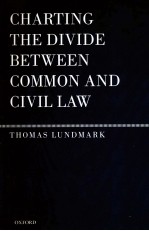图书介绍
Charting the Divide Between Common and Civil LawPDF|Epub|txt|kindle电子书版本网盘下载

- Lundmark 著
- 出版社: Incorporated
- ISBN:
- 出版时间:2012
- 标注页数:465页
- 文件大小:21MB
- 文件页数:479页
- 主题词:
PDF下载
下载说明
Charting the Divide Between Common and Civil LawPDF格式电子书版下载
下载的文件为RAR压缩包。需要使用解压软件进行解压得到PDF格式图书。建议使用BT下载工具Free Download Manager进行下载,简称FDM(免费,没有广告,支持多平台)。本站资源全部打包为BT种子。所以需要使用专业的BT下载软件进行下载。如BitComet qBittorrent uTorrent等BT下载工具。迅雷目前由于本站不是热门资源。不推荐使用!后期资源热门了。安装了迅雷也可以迅雷进行下载!
(文件页数 要大于 标注页数,上中下等多册电子书除外)
注意:本站所有压缩包均有解压码: 点击下载压缩包解压工具
图书目录
PART ONE: General Topics3
1.The Discipline of Comparative Law3
A.The Uses (Misuses, and Abuses) of Comparative Law5
B.The Purposes of Comparative Law10
C.Some Approaches to Comparative Legal Studies15
1.Micro.or Rule.based Comparisons18
a.Comparison of Legal Terms19
b.Comparison of Legal Concepts20
c.Comparison of Norms21
d.Comparison of Sources of Rules22
e.Comparison of Legal Institutions23
f.Comparison of Bodies of Norms23
2.Macro.Comparisons24
a.Comparison of Legal Organizations25
b.Comparison of Legal Systems25
c.Comparison of Mentalites26
d.Comparison of Juristic Styles26
e.Comparison of Legal Philosophies27
f.Comparison of Legal Traditions29
g.Comparison of Legal Cultures30
D.Classifications in Comparative Law30
1.Language as a Model for Classifications in Law31
2.Legal Families33
3.Some Suggestions for Possible Taxonomic Studies38
a.Bottom.up Approach38
b.Top.down Approach40
c.Comparison at the Middle, including Legal Transplants42
4.On Using Language as a Tool for Classification44
Summary46
2.Comparative Legal Linguistics51
A.Legal Linguistics52
1.The History of Legal German53
2.The History of Legal English54
3.Characteristics of Legal German57
4.Characteristics of Legal English65
B.Language and Legal Predictability74
Summary86
3.Comparative Jurisprudence89
A.Three Conceptions of Law91
1.Legal Positivism91
2.Natural Law93
3.Legal Realism95
B.Evaluating the Jurisdictions96
1.Is Law Autonomous or Interdisciplinary?101
a.Germany103
b.The United States of America105
c.Sweden108
d.England and Wales109
2.Is Law Complete or Incomplete?110
a.Germany112
b.The United States of America113
c.Sweden114
d.England and Wales114
3.Determinable Versus Indeterminable115
a.Germany116
b.The United States of America118
c.England and Wales120
d.Sweden122
4.Predictability of the Law Versus Individual Justice122
a.Germany124
b.The United States of America124
c.England and Wales125
d.Sweden125
5.Formality Versus Morality126
a.Germany128
b.The United States of America129
c.England and Wales129
d.Sweden130
Summary130
PART TWO: Legal Actors141
4.Lawyers141
A.Historical Development141
1.Germany141
2.England and Wales145
3.Sweden147
4.The United States of America148
B.Modern Legal Education150
1.Germany150
2.England And Wales157
3.Sweden159
4.The United States of America159
C.The Legal Profession163
1.Germany163
2.England and Wales166
3.Sweden168
4.The United States of America170
Summary172
5.Judges and Judiciaries176
A.Historical Development176
1.Germany176
2.England and Wales180
a.Common Law Courts180
b.Chancery181
3.Sweden182
4.The United States of America183
B.Court Structure185
1.Germany185
a.Ordinary Jurisdiction185
b.Specialist Jurisdiction187
Ⅰ.LABOR MATTERS187
Ⅱ.SOCIAL MATTERS187
Ⅲ.TAX MATTERS187
Ⅳ.ADMINISTRATIVE MATTERS188
2.England and Wales188
a.Tribunals188
b.Magistrates’ Court189
c.County Court190
d.Crown Court191
e.High Court of Justice192
f.Court of Appeal of England and Wales193
g.Supreme Court of the United Kingdom193
3.Sweden194
a.Special Courts194
b.Ordinary Jurisdiction195
c.Administrative Jurisdiction197
4.The United States ofAmerica198
a.The Federal Court System199
b.The California State Courts201
C.The Selection, Training, and Tasks of Judges202
1.Germany202
a.Training and Selection202
b.Tasks203
2.England and Wales204
a.Selection204
b.Education206
3.Sweden206
4.The United States of America207
a.Federal Courts207
b.The California State Courts208
Summary209
6.Lay Judges and Juries214
A.Historical Development214
1.Germany214
2.England and Wales218
a.Justices of the Peace219
b.Juries220
3.Sweden221
4.The United States ofAmerica224
a.Justices of the Peace224
b.Juries225
B.Selection and Training227
1.Germany227
2.England and Wales232
a.Justices of the Peace232
b.Juries236
3.Sweden237
4.The United States of America239
a.Justices of the Peace239
b.Juries240
C.Justifications for Lay Judges and Juries241
1.Germany241
2.England and Wales245
3.Sweden248
4.The United States of America249
a.Justices of the Peace249
b.The Institution of the Jury250
c.Civil Juries252
d.Criminal Juries253
Summary255
PART THREE: Legal Rules261
7.Legal Reasoning261
A.Law, Rules, Norms, Making Law, and Finding Law261
1.Finding the Law: the Normsuche262
2.Systematization and the Normsuche263
3.Putting a Judicial Gloss on a Statute268
4.Making Law269
B.Four Steps in Making and Applying the Law273
C.The Thinking Processes in Making Law277
D.Logic and Legal Reasoning280
1.Logical280
2.Reasoning by Deduction281
3.Reasoning by Induction281
4.Reasoning by Analogy281
5.The Logical Syllogism283
6.The Legal Syllogism or “Subsumption” (Applying the Law to the Facts)284
E.Mischaracterizations of Common Law Reasoning287
Summary292
8.Statutes and their Construction294
A.Historical development294
1.Germany295
2.England and Wales303
3.Sweden306
4.The United States of America308
B.Legal Sources and Hierarchies310
1.Germany313
a.Constitutional Law313
b.European Law314
c.International Law314
d.Statutory Law315
e.Legal Regulations315
f.Ordinances (by.laws)315
g.Collective Bargaining Agreements316
h.Administrative Rules316
i.Customary Law316
j.Case Law (Richterrecht)316
k.Expert Opinion Law (Juristenrecht)?317
2.England and Wales317
3.Sweden320
4.The United States ofAmerica321
C.Statutory Interpretation324
1.Germany324
a.Linguistic Interpretation325
b.Historical Interpretation327
c.Teleological Interpretation330
2.England and Wales332
3.Sweden335
a.Grammatical Interpretation (logisk.grammatisk tolkning)335
b.Systematic Interpretation (systematisk tolkning)336
c.The Teleological Methods of Interpretation (subjektiv och objektiv lagtolkning)336
4.The United States ofAmerica337
Summary339
9.Judicial Precedents343
A.Historical Development344
1.Germany344
2.England and Wales347
3.Sweden350
4.The United States of America352
B.Statutes Regarding Precedential Effect354
1.Germany354
a.The Vertical Effect of Precedents354
b.The Horizontal Effect of Precedents356
2.England and Wales358
3.Sweden359
a.The Vertical Effect of Precedents359
b.The Horizontal Effect of Precedents360
4.The United States ofAmerica361
C.The Modern Use of Precedents362
1.Germany362
2.England and Wales371
3.Sweden374
4.The United States of America375
D.Precedents and Politics in the German Federal Constitutional Court377
1.The FCC as Institution379
a.Organization of the FCC379
b.Appointment of Judges to the FCC380
c.Jurisdiction of the FCC381
d.Normative Force of the FCCs Judgments381
2.Departures from Precedent by the FCC386
a.Style of FCC Judgments386
b.Kinds of Departures386
c.Departures by the First Senates of the FCC387
d.Departures by the Second Senate of the FCC392
3.Short Comparison with the U.S.Supreme Court395
4.Explaining the Small Number of Departures from Precedent by the FCC, and the Large Percentage of Political Departures396
Summary402
CONCLUSION411
BIBLIOGRAPHY437
INDEX455